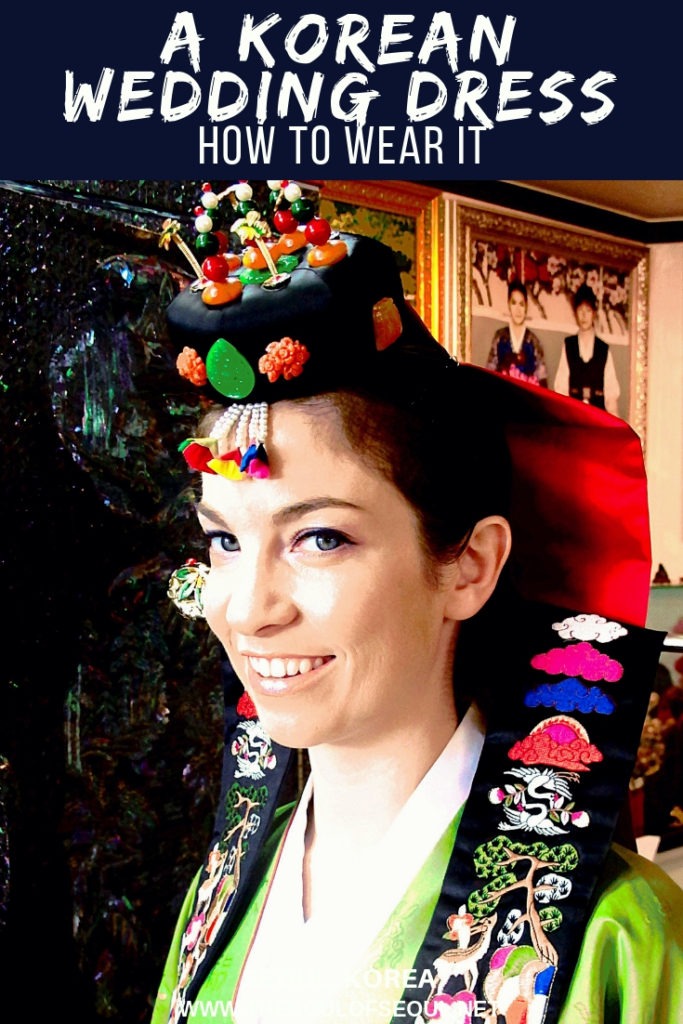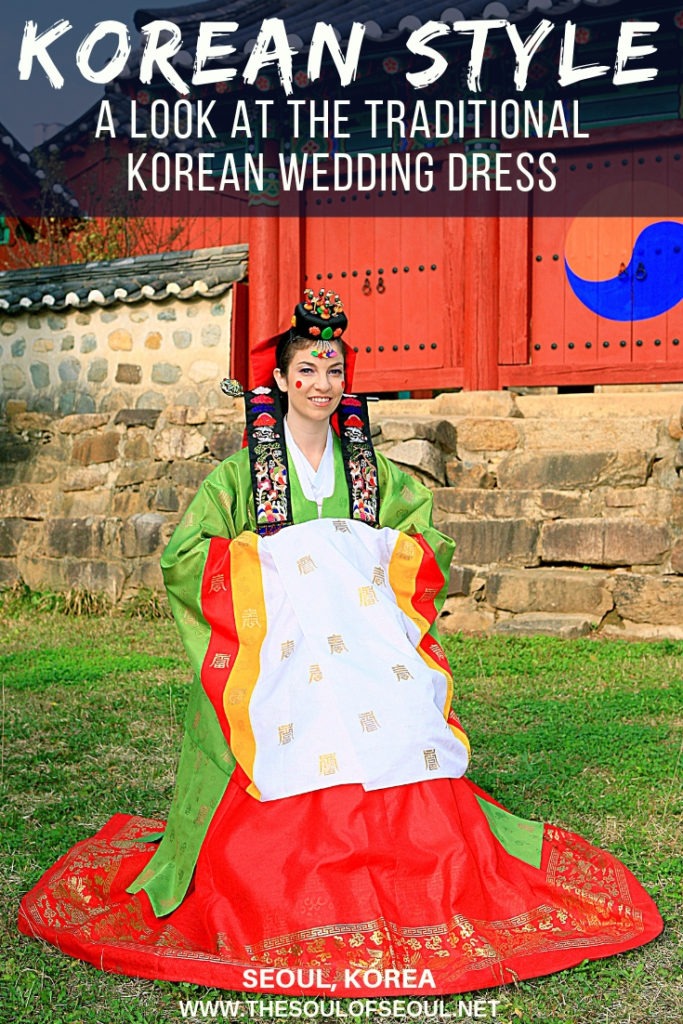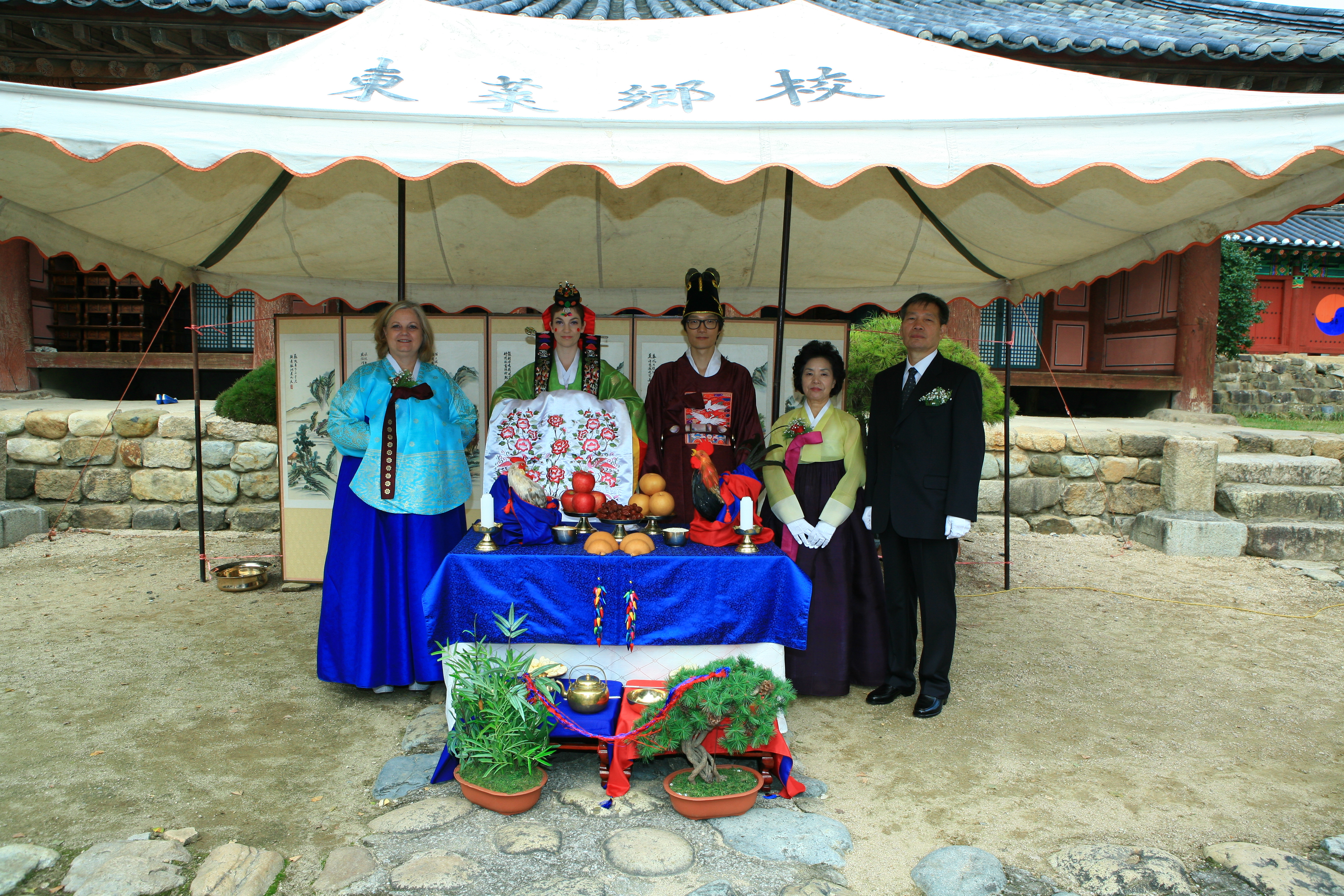What Does A Traditional Korean Wedding Dress Look Like?
When I began planning our wedding ceremonies (yes, we had two!), the American wedding ceremony being much more familiar was a breeze. When it came to the Korean ceremony, there were so many questions that stood out like: What does a Korean wedding dress look like? What do Korean women wear in a wedding? Is there a traditional Korean wedding dress? Or, do women wear more modern dresses these days? I wanted to be culturally appropriate and we decided to go traditional because we’d be doing a traditional American ceremony as well.
There is in fact a difference in the traditional Korean wedding dress versus the standard traditional dress, or Hanbok, and even more so from the modern Hanboks that are now being designed. There was a lot of decoration to be done I hadn’t known about. I was thankful to have a team of helpful assistants getting me ready.

(This post contains affiliate links, which means I receive a certain percentage of a sale if you purchase after clicking at no cost to you. Thank you for your support.)
The Hanbok has roots dating as far back in Korean history as the Three Kingdoms Period (57BC – 668AD). Today, the style of the Hanbok is most similar to the Joseon period in Korea from 1392-1910. I’ve always thought Hanboks were beautiful when I’ve had a chance to see Koreans wearing them and I was excited to get to wear one for our ceremony. The Hanbok isn’t about being tight fitting or showing off curves, but the elegance and style when the women seemingly float across the floor in the abundance of cloth draped around them.

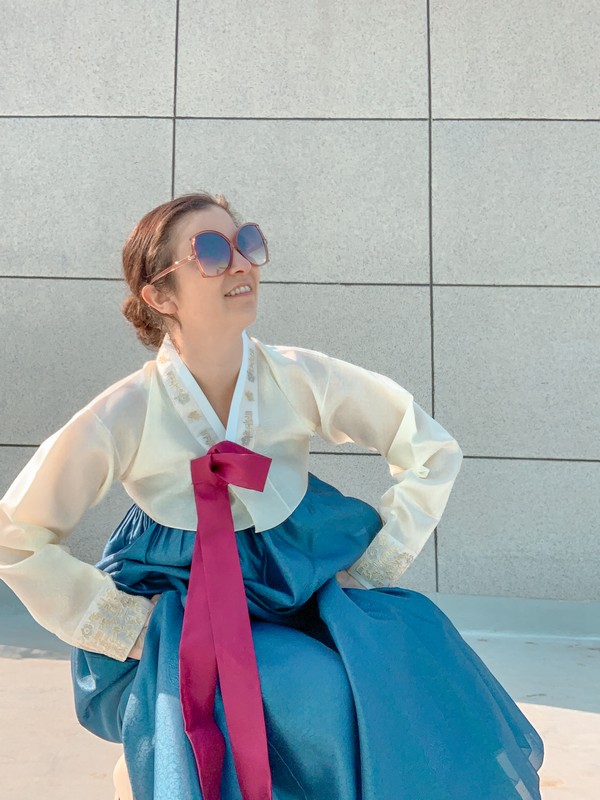
Most visitors to Korea will have the opportunity to wear a Hanbok if they visit places like Bukchon Hanok Village in Seoul where there are rental shops galore. I remember the first time I saw a traditional performance and it was amazing to see the women with such intricate movements look so elegant. If you haven’t seen a traditional performance, I highly recommend it. Its a great way to appreciate the art of Korean traditional dance and the traditional clothing. Korea House has an amazing experience with traditional court cuisine and a performance. Jeongdong Theater also has some great performances including ‘The Palace: Tale of Jang Noksu’.
Getting Ready For a Korean Traditional Wedding
Getting ready for the Korean traditional wedding ceremony was, I assume, similar to what it will be like getting ready for the American ceremony in a few months. Make-up preparation taking longer than I’m used to and putting on clothes that I’ll never wear again and mean so much. The only difference is I know what to expect in the American style and with the Korean one I was moved around by two Korean women getting me all done, thankfully, since I wouldn’t have known where to start.
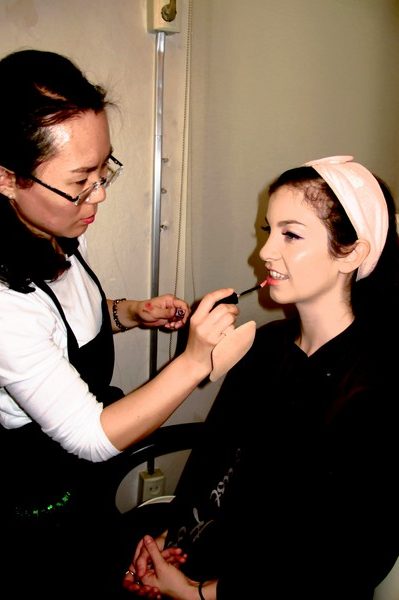
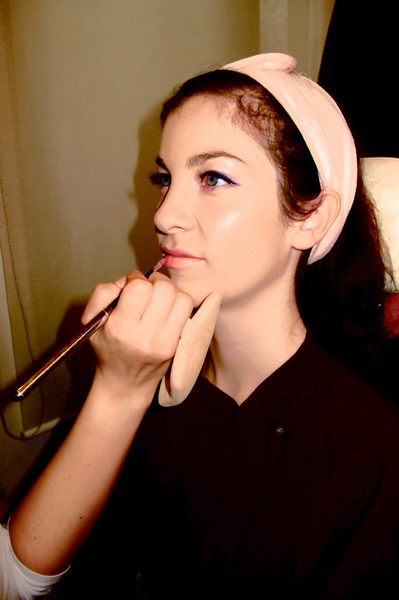
Three hours before the ceremony was set to begin I got settled in the make-up chair at the Traditional Ceremony Shop in Busan, my husband’s hometown, ready to get my traditional Korean look on. My two younger sisters, mother and Jae-oo and his friend sat around eating ramyeon just behind me as my stomach growled in the make-up chair. The women wanted to get me started so I couldn’t eat until after I’d gotten my face all finished up. They told me it’d take an hour to get all of the make-up done and that it did. I had no idea make-up could ever take that long. A little cover-up, mascara and two minutes later I’m usually out the door. But she did a fabulous job making me look like a porcelain doll.
After I gulped down my ramyeon and took the bathroom break they said would be my last until after the ceremony had ended, the Hanbok was removed from the hanger so that we could start the layering process.
The Traditional Korean Wedding Hanbok
The traditional Korean wedding Hanbok has layers galore. A normal Hanbok has a couple layers as well, but this one had a couple beyond that. First was the sokchima, a corset-like layer with a skirt attached, which isn’t pictured as the Korean women thought taking pictures of the under things wasn’t proper, though you really couldn’t see anything. The second layer was the red dress or chima, the Hanbok skirt.
Next the Hanbok jacket, or jeogori, was put on. A few minutes later, upon adding the fourth part, I was asking myself what the point of the jeogori was since you couldn’t even see it. But such is tradition and I didn’t really voice this question to anyone.


Next was the wonsam or hwalot, the ceremonial jacket worn by queens and upperclass women during the Joseon dynasty. The wonsam is colorful and rather elaborate with red silk on the outside and blue silk on the inside and flowers embroidered in the material to represent wealth, longevity and nobleness. Red was used for queens generally while green wonsams were used for princesses. Today, you can choose which you prefer.
After the wonsam was added the women wrapped a blue ribbon around my chest to hold it in place. This belt of sorts is called a daedae and is red woven silk with gold embroidery.
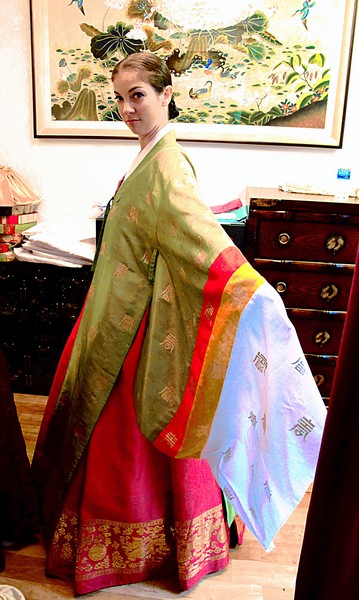
At this point the clothing part of the Hanbok was basically finished. Some socks, or beoseon, that resemble footwear fit for an elf were put on and I sat down to get the head pieces in place. First, the jokduri was added.

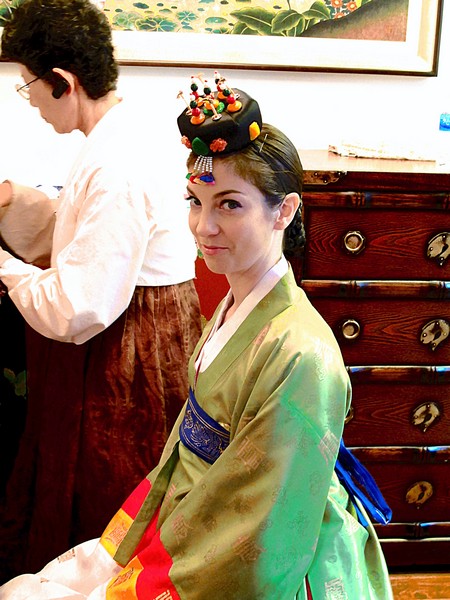
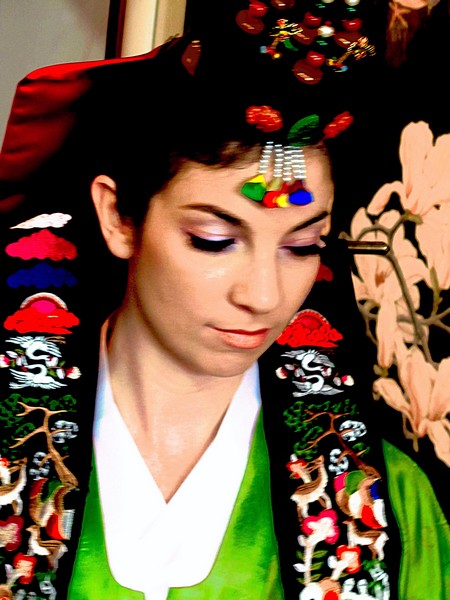
Earlier, after my make-up had finished being applied and before I started getting dressed, one of the women did my hair. She put my shoulder length hair up in a bun and then took a long length of fake braided hair and pinned it in as well. When I asked my mom what it looked like she said it looked like an upside down horse-shoe shape. At that time I didn’t really know what that was for, but upon sitting down in the chair to get my head-pieces added it soon became clear.

The jokduri was coming next. This is a cap that was used by Mongolian women but became smaller and used an accessory by Korean women. Jokduri worn by royalty had different colors and today if you go to rent a Hanbok or have a Hanbok experience, you’re likely to have many to choose from.
After the jokduri was put on, a long hairpin, or binyeo was placed through the loops made by the fake hair and fastened so as not to fall out. The ends of the binyeo stuck out about 3 to 4 inches on either side of my head.
Daenggi, or pieces of cloth, were attached to either side and hung down in front of my chest. Another piece of cloth was then attached to hang down in the back. The whole contraption made walking through doorways later interesting and when it was finally removed 2 hours later I was very thankful as it wasn’t too bad at the beginning, but became heavier and heavier over the course of the ceremony. She did a stupendous job of getting it firmly attached though. I had to do full bows down to the floor at least 20 times over the course of the ceremony and paebeck and it didn’t budge at all.
Finally, the shoes were put on and we made our way to the wedding ceremony location.


Ever want to dress up in a traditional Korean wedding Hanbok and get photos? You actually can. Klook has a traditional wedding ceremony experience and it looks just like you see here. Check it out if you want some of your own traditional pics.

Do Hanbok colors have meaning?
Originally the colors of the Hanboks had meaning and when we went to pick out our jacket colors I put up a bit of a fuss when I was asked what color I liked and I asked the woman what color was traditional to which she responded by asking me again what color I liked. I was under the impression we were having a traditional ceremony and therefore should really be traditional about it.
I know these days people just choose the color they like and that’s what they wear, but at one time they did have meanings and I didn’t want to go walking down the aisle in a Hanbok that meant something about me that wasn’t the case that perhaps someone might understand. When I did push it a bit further she said she didn’t know the meanings of the colors and then I understood why she wasn’t answering my question.
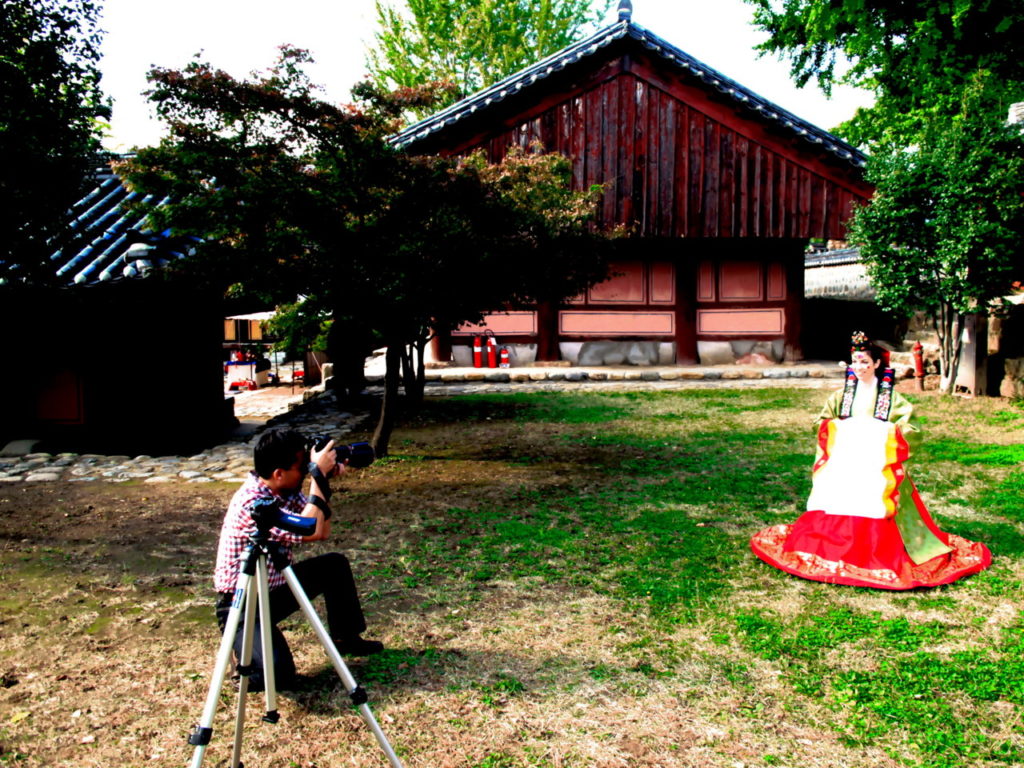
The red skirt, traditionally worn at wedding ceremonies, symbolizes wealth and good fortune. Good thing I wore that one. Traditionally the yellow wonsam was for empresses, the red wonsam for the queen, magenta for concubines and princess consorts, and green for princesses and women of the noble class. I ended up with green, though not because of the meaning, which I didn’t know until later upon further searching on the internet, but because I liked the color.
Want to see what the traditional Korean wedding ceremony entailed? Click here because it was all sorts of interesting steps. There was even a piggyback paebaek at one point.
Did you like this post? Pin It!
